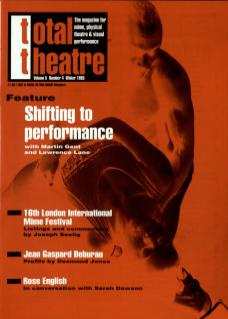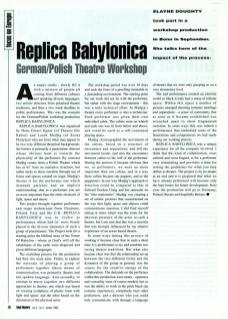An empty studio – slowly fill it with a mixture of people all coming from different cultures and speaking diverse languages; two artistic directors from polarised theatre traditions, and then a two week deadline to public performance. This was the scenario for the German/Polish workshop production Replica Babylonica.
Replica Babylonica was organised by Hans Dieter Ilgner (of Theatre Die Raben) and Lasek Madjig (of Scena Plastyczna) who are from what may appear to be two very different theatrical backgrounds. The former is primarily a pantomime director whose obvious bent is towards the physicality of the performer. By contrast Madjig comes from a Polish Theatre which has at its base no narrative structure, but rather seeks to show emotion through use of forms and spaces created on stage. Madjig's theatre is for the performer one which demands patience, and an implicit understanding that as a performer you are no more important than the other elements of light, space and music.
This project brought together performers and stage technicians from Germany, Poland, Italy and the UK. Replica Babylonica was to evolve as performance which had its roots firmly placed in the diverse dynamics of such a group of practitioners. The Project took for a starting point the biblical story of the Tower Of Babylon – where at God's will all the inhabitants of the earth were dispersed and given different languages.
The workshop process for the production had then two main aims. Firstly, to explore the outcome of placing a group of performers together whose means of communication was primarily theatre and not spoken language. And secondly, to attempt to marry together two different approaches to theatre; one which was based on creating sculptures of plastic form with light and space, and the other based on the dynamism of the physical actor.
The workshop period was over ten days and took the form of a gruelling timetable in a demanding environment. The starting point for our work did not lie with the performer, but rather with the stage environment – this was a truly technical affair. In Madjig's theatre every performer is also a technician. Each performer was given their own individual cabin. The cabins were on wheels and each one was lit from below and above, and could be used as a self-contained playing space.
Madjig choreographed the movement of the cabins, based on a structure of encounters and separations, and left the movement inside, and also the encounters between cabins, to the will of the performer. During the process it became obvious that we, as performers, were no more important than our cabins, and in a way these cabins became our puppets, and us the puppeteers. In one way Madjig's approach to direction could be compared to that of Edward Gordon Craig and his rationale on the ‘ubu marionette’. Madjig was creating a set of artistic pictures that concentrated on the way that light, space and objects could communicate emotion. I did find myself asking at times where was the room for the physical presence of the actor in such a theatre, but I am sure that this was a reaction that was strongly influenced by my relative experience of an actors-based theatre.
In some ways during this process of working it became clear that in such a short time it is problematic to try and combine two strong theatre traditions. But what also became clear was that the relationship set up between the two different forms and the dynamics of the group in general, was the source for the creative energy of the collaboration. The demands on the performer within this production were many – openness and versatility were of course needed, but so was the ability to work in the pitch black (an extreme experience), and to completely trust other performers and a director who you could only communicate with through a language of theatre that you were only grasping at, on a very elementary level.
The end performance created an extreme world so black it truly had a sense of infinite space. Within this space a number of pictures emerged showing tortuous meetings and separations – a sense of community that as soon as it became established was wrenched apart to show fragmented isolation. In some ways this was indeed a performance that embodied some of the frustrations and compromises we had made during our working process.
Replica Babylonica was a unique experience for all the company involved. I think that this kind of collaboration, cross cultural and cross lingual, is for a performer very stimulating and provides a time for testing the guidelines for what you may define as theatre. The project is by no means at an end and it is proposed that what we have already performed will become only the bare bones for future development. Next year the production will go to Germany, Poland, Russia and hopefully Britain.

